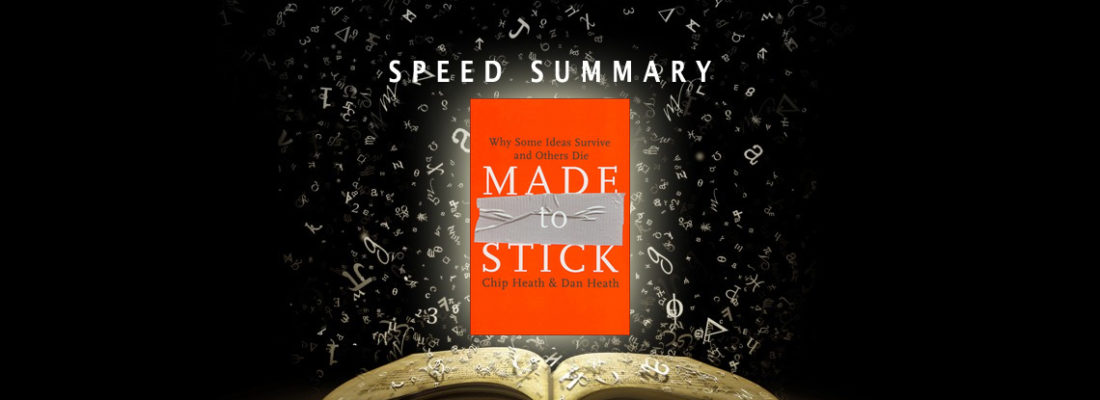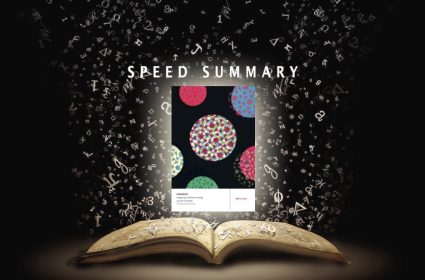Made to Stick: Why Some Ideas Survive and Others Die [Speed Summary]

- Made to Stick: Why Some Ideas Survive and Others Die
- Author: Chip Heath and Dan Heath
- Publisher: Random House
- Publication: 2007
What makes an idea psychologically sticky? The answer is SUCCESs. Made to Stick distills years of research and communication science into an easy-to-remember mnemonic and blueprint for creating ‘sticky ideas’; ideas that get understood, remembered and that change something – minds or behaviours. And in doing so, authors Chip and Dan Heath offer an evidence-led deep-dive into the murky middle section of Malcolm Gladwell’s hit on how hits happen – The Tipping Point – ‘the Stickiness Factor’.
- SIMPLE – Psychologically sticky ideas are simple and short; they are often distillations of complex, multifaceted ideas or concepts into a single core idea that is easy to get and that can be embodied in a compact plain-English phrase or sentence. For example, the simple core of SouthWest airlines is ‘THE low-fare airline’ – something that everyone gets and that can guide innovation and marketing. So try using the ‘Hollywood Pitch’ technique to get your idea across in one short memorable phrase; Speed; it’s Die Hard on a bus’ and Alien; it’s Jaws on a spaceship. Simple and Short is Sticky.
- UNEXPECTED – Psychologically sticky ideas are surprising and interesting; they grab our attention by defying our expectations, and keep our attention by teasing our curiosity. They also make sense. So surprise is not about randomness but about creating a ‘huh?’ moment and then an ‘a ha!’ moment. A ‘radio that fits in your pocket’ (a pocket radio), like a ‘man on the moon’ both surprised and teased, but then they made sense. So look for knowledge gaps in people’s minds, and appeal to curiosity in a surprising way.
- CONCRETE – Psychologically sticky ideas are tangible, real and appeal to our (five) senses. So don’t sell the soft hands, sell the hand cream. An attribute – hand cream – is concrete, a benefit – soft hands is abstract. Don’t sell a concept, sell a prototype. Don’t sell with statistics, sell with examples. For example, people give prefer to give donations to real people, not abstract causes (Plan International). So make it real, and avoid abstractions, metaphor, numbers and jargon like the plague. Use the senses and sensory language to paint a vivid mental picture; we remember urban legends like ‘kidney heist’ and ‘boyfriend death’ because the vivid imagery and details that appeal to our senses (waking up in bloodied bath, noise of hanging body scraping on car).
- CREDIBLE – Psychologically sticky ideas are believable – they have both ‘internal credibility’ (they make sense, and are not self-contradictory) and ‘external credibility’ (they have proof or authority to support them). So make your idea psychologically sticky, make sure it makes sense, and offer proof by example, proof by numbers, or proof by authority – or anti-authority. For example, use an image of a dying smoker to ‘prove’ smoking is bad for you. Or use rave reviews and popularity as proof you’re as good as you say you are. And let people try-before-they-buy to prove to themselves you’re worth it. Finally, use the ‘Sinatra Test (‘if I can make it there, I can make it anywhere.’) by deploying an extreme example to prove your worth (‘the makeup of make up artists’).
- EMOTIONAL – Psychologically sticky ideas move us, they evoke emotions, make us feel something – and in doing so they make us _care_. So to make your idea sticky, focus either on what people already really care about – usually themselves (self-interest) – or create an association between your idea and something they care about (again, usually themselves). It’s not so much about selling the benefit (soft hands) and not the attribute (hand cream), but about laddering up the emotional ladder to higher-order self interest by appealing not just to what they want, but who they want to be (someone more attractive). The golden rule of John Caples, one of the top copywriters of all time, still stands; ‘First and foremost, try to get self-interest into every headline you write’, but move beyond the beyond basic benefits and basic emotional drivers (sex, greed and fear).
- STORY: Psychologically sticky ideas tend to be in story format, and have simple story plots that people can relate to. Statistics may be dire, but stories inspire – and if a picture speaks a thousand words, a story beats a thousand facts and figures. Subway’s low fat subs were brought to life by the story of Jared Fogle who lost over 100lbs in three months on an all-Subway diet. Interestingly, three simple plot lines pattern sticky ideas (for example over 80% of the stories in Chicken Soup for the soul fit these plot lines)- The Challenge Plot (inspiring grit – Rocky-style underdog story, championing people overcoming adversity)
– The Connection Plot (inspiring relationships – Romeo & Juliet style story, championing people bridging a gap (racial, social, traditional) connecting against all odds)
– The Creativity Plot (inspiring ingenuity – The MacGyver style-story championing people using their smarts to achieve their goals)Bottom line, stories sell, because they inspire and motivate us to be better.
The BG Take
Made to Stick, with its sticky SUCCESs mnemonic, is a great read that’s full of great advice for innovators and communicators more interested in practice than theory. The over-arching theme is that we need to cure the ‘curse of knowledge’ when communicating our ideas (whether concepts, strategies or ads); we know what we mean but others often don’t. The authors demonstrate this vividly with “the tap test”. If you tap out the tune to a universally known song (like ‘Happy Birthday’ on a table to a room of people, you’d probably guess that 50% of them would guess the tune. You’d be wrong – only 1 in 40 would get it. You know the tune, because you’re mentally humming it – you are cursed with knowledge of the tune – which results in non- or mis-communication. It’s a point well made – marketing jargon gets in the way of marketing – internally and externally. To that end, we’re going to ensure our product concepts are all SUCCESs-ful.





